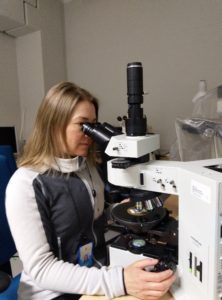 Researcher: M.Sc. Rita Kallio
Researcher: M.Sc. Rita Kallio
Supervisors: Professors Timo Fabritius (Metallurgy), Saija Luukkanen (Mineral Processing) and Ulla Lassi (Hydrometallurgy)
Description of the project:
Scandium provides technological advantages, particularly in solid oxide fuel cells and aluminum alloys, in respect of transportation applications due to its capacity to increase strength and weldability. The focus of this project is to develop a material and cost-efficient process to extract scandium from the recently discovered Kiviniemi mafic intrusion, which is a primary scandium occurrence with estimated 13.4 Mt @ 163 ppm Sc. Based on the geochemical characteristics of scandium, its enrichment to ore grades by geological processes is scarce. Consequently, the estimated global scandium production is currently only 15 t/a. Given the limited volume of the current global scandium production, the Kiviniemi deposit provides a potential new source for the expectedly increasing demand of this unique rare earth metal, classified as a critical raw material for the European Union. There are no other Kiviniemi-type scandium deposits known in Europe. In the Kiviniemi deposit, scandium occurs in pyroxene and amphibole, which respond well to magnetic preconcentration (Figure 1). In addition to the conventional preconcentration methods, the proposed processing scheme investigated in this research project includes high-temperature upgrading of the concentrate to produce Sc-containing amorphous phase along with crude iron. The Sc-containing amorphous phase is further treated with hydrometallurgical processes to produce the desired Sc2O3-product. The purpose of this research is to investigate the main features and boundary conditions related to each proposed step, the results of which will be published in relevant journals. This project promotes the beneficiation of the Kiviniemi scandium deposit through interdisciplinary research, extending from mineral processing to the pyrometallurgical treatment and hydrometallurgical aspects of scandium extraction.
Figure 1. Stereomicroscope images of dry magnetic separated fractions from a Kiviniemi sample. The dark particles (black and green) represent scandium-containing pyroxene and amphibole, together with ilmenite, iron oxides and sulfides. The red grains are garnet (almandine) and the colorless or slightly yellow/orange grains are mainly plagioclase and potassium feldspar. A-D): 250-500 µm size fraction separated with A) hand magnet, B) Frantz 0.4 A, C) Frantz 0.8 A and D) Nmags; E-H): 125-250 µm size fraction; I-L): 63-125 µm size fraction; and M-P): 32-63 µm size fraction, separated in respective order.




